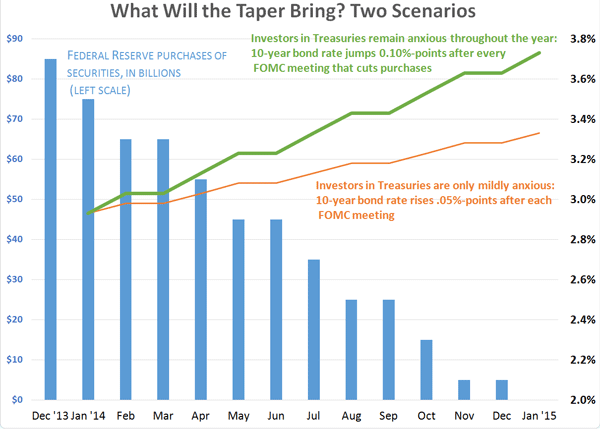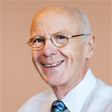Interest Rates and the Fed’s Taper
What happens in January could set the tone for long-term rates for the rest of the year.
With the long-awaited “tapering” of the Federal Reserve’s bond-buying here, the question is, what does it mean for long-term interest rates? How much and how fast they rise depends on whether investors take up the slack. If other bond buyers step up to the plate in January, then rate increases will be small over the course of the next year. If not, investor anxiety will push up rates faster. Short-term rates will not be affected until late in 2015, when the economy is likely to be strong enough and unemployment, low enough for the Fed to hike the federal funds rate.
Outgoing Federal Reserve Chairman Ben Bernanke made it official that the central bank will start trimming its bond purchases in January. Though he announced only a first $10-billion reduction in the Fed’s $85 billion-a-month purchases of long-term securities, he implied that further cuts would be forthcoming at regular intervals if all goes according to plan. He also, of course, reserved the right to delay cuts if it doesn’t.
The impact on interest rates is likely to be a gradual rise in long-term rates, pushing them to somewhere between 3.3% and 3.6% at the end of 2014. Here’s why:

Sign up for Kiplinger’s Free E-Newsletters
Profit and prosper with the best of expert advice on investing, taxes, retirement, personal finance and more - straight to your e-mail.
Profit and prosper with the best of expert advice - straight to your e-mail.
The timing of the wind-down is ruled to a significant degree by when the policy-setting Federal Open Market Committee meets, because its members vote on whether to cut purchases and by how much. At any time, the FOMC could elect to accelerate, decelerate or even suspend the planned reductions in bond purchases, depending on how the economy -- in particular, inflation and unemployment -- are developing.
There are eight scheduled meetings in 2014. If the committee decides at each meeting to systematically cut its buying by $10 billion monthly, with a final $5 billion purchase, it would wrap up quantitative easing by the end of 2014. Between now and then, the Fed would still buy $460 billion or more of long-term securities, pushing its balance sheet of securities, loans and other assets to $4.5 trillion by the time the program ends.
If interest rates rise by about 0.1 percentage point every time the Fed cuts, the 10-year Treasury bond will end 2014 at just above 3.6%. That’s how much rates rose in the 24 hours immediately following the Fed’s announcement that it would start tapering. It’s reasonable to assume that rates could continue to climb that much with each reduction in the amount of monthly quantitative easing, if investors in Treasuries remain nervous that demand for long-term securities will fall as the Fed exits.
January could set the tone for interest rates for the rest of the year. If, however, investors see other bond buyers step up to the plate in January and each time thereafter, replacing Fed purchases to hold demand steady, nervousness will be muted. Long-term rates would likely climb by only about half that amount with each Fed meeting, and they’d wind up at about 3.3% at the end of 2014.

Fed policymakers could speed up the process, of course, cutting by increments greater than $10 billion each month. One reason for doing so is the ballooning size of the Fed’s portfolio. It makes markets uneasy to see the Fed holding such an enormous quantity of long-term securities, and some Fed officials fear that the size of the portfolio creates another policy dilemma: how the Fed can divest itself without roiling markets. Reducing quantitative easing faster also appeals to those who favor injecting less stimulus into the economy and allowing it to stand on its own feet sooner. Ditto, those who worry the Fed’s huge purchases potentially contain seeds of a longer-term problem with inflation.
Conversely, the Fed could temporarily suspend or skip an opportunity at one or more FOMC meetings to trim bond buying if recovery falters or interest rates rise too quickly. But a pace of about a $10-billion reduction for each FOMC meeting is the most likely.
Note that the financial markets reacted in diverse ways to the Fed’s announcement. The stock market rallied, heartened that the Fed judged the economy to be making progress, while, predictably, long-term bond prices fell and rates rose. Short-term rates, however, were virtually unchanged and will likely remain so for some time. Bernanke’s reaffirmation of the Fed’s patience plus the publicly announced views of FOMC members both point to a date in late 2015 as the most likely time for the Fed to hike the federal funds rate. It’ll take until then for the jobless rate to fall well below 6.5%, the Fed’s previously announced threshold for possible action.
Five years ago, a raging financial crisis was pulling well-known Wall Street firms into the ashes and devastating lives on Main Street as jobs disappeared and homes were foreclosed. The start of the Fed’s tapering can be seen as a historic step away from an extraordinary period of monetary stimulus.
Get Kiplinger Today newsletter — free
Profit and prosper with the best of Kiplinger's advice on investing, taxes, retirement, personal finance and much more. Delivered daily. Enter your email in the box and click Sign Me Up.

-
 Designing Your 'Immortal' Financial Plan
Designing Your 'Immortal' Financial PlanExplore an approach that offers solutions for those navigating the intersection of longevity, fulfillment and financial security.
By Dennis McNamara
-
 How to Protect Your Privacy While Using AI
How to Protect Your Privacy While Using AIHow to keep your information and finances safe while using AI, including ChatGPT and Perplexity.
By Bob Haegele
-
 The AI Doctor Coming to Read Your Test Results
The AI Doctor Coming to Read Your Test ResultsThe Kiplinger Letter There’s big opportunity for AI tools that analyze CAT scans, MRIs and other medical images. But there are also big challenges that human clinicians and tech companies will have to overcome.
By John Miley
-
 The New Space Age Takes Off
The New Space Age Takes OffThe Kiplinger Letter From fast broadband to SOS texting, space has never been more embedded in peoples’ lives. The future is even more exciting for rockets, satellites and emerging space tech.
By John Miley
-
 Rising AI Demand Stokes Undersea Investments
Rising AI Demand Stokes Undersea InvestmentsThe Kiplinger Letter As demand soars for AI, there’s a need to transport huge amounts of data across oceans. Tech giants have big plans for new submarine cables, including the longest ever.
By John Miley
-
 What DOGE is Doing Now
What DOGE is Doing NowThe Kiplinger Letter As Musk's DOGE pursues its ambitious agenda, uncertainty and legal challenges are mounting — causing frustration for Trump.
By Matthew Housiaux
-
 A Move Away From Free Trade
A Move Away From Free TradeThe Letter President Trump says long-term gain will be worth short-term pain, but the pain could be significant this year.
By David Payne
-
 Trump’s Whirlwind Month of Crypto Moves
Trump’s Whirlwind Month of Crypto MovesThe Kiplinger Letter The Trump administration wants to strengthen U.S. leadership in the cryptocurrency industry by providing regulatory clarity.
By Rodrigo Sermeño
-
 Donald Trump Tests His Limits
Donald Trump Tests His LimitsThe Kiplinger Letter President Encounters Legal Obstacles in Pursuit of Ambitious Agenda.
By Matthew Housiaux
-
 Another Down Year for Agriculture
Another Down Year for AgricultureThe Kiplinger Letter Farmers brace for falling incomes, widening trade deficits
By Matthew Housiaux
